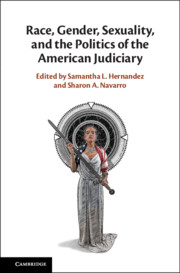Book contents
- Race, Gender, Sexuality, and the Politics of the American Judiciary
- Race, Gender, Sexuality, and the Politics of the American Judiciary
- Copyright page
- Dedication
- Contents
- Figures
- Tables
- Contributors
- Acknowledgments
- Introduction
- 1 Qualification, Selection, and Retirement Characteristics of Women, Minorities, and Minority-Women State Supreme Court Judges
- 2 Latinas and the Texas Judiciary
- 3 Structural and Partisan Effects on the Ascension of Women of Color to State Appellate Courts
- 4 LGBT Judges in the United States
- 5 Race, Gender, and the Battle to Seat Constance Baker Motley, the First Black Woman Appointed to the Federal Bench
- 6 Diversity Abound
- 7 Marked for Excellence
- 8 Navigating Rising to the Top: Justice Sotomayor
- Concluding Remarks
- Index
- References
1 - Qualification, Selection, and Retirement Characteristics of Women, Minorities, and Minority-Women State Supreme Court Judges
Published online by Cambridge University Press: 09 November 2018
- Race, Gender, Sexuality, and the Politics of the American Judiciary
- Race, Gender, Sexuality, and the Politics of the American Judiciary
- Copyright page
- Dedication
- Contents
- Figures
- Tables
- Contributors
- Acknowledgments
- Introduction
- 1 Qualification, Selection, and Retirement Characteristics of Women, Minorities, and Minority-Women State Supreme Court Judges
- 2 Latinas and the Texas Judiciary
- 3 Structural and Partisan Effects on the Ascension of Women of Color to State Appellate Courts
- 4 LGBT Judges in the United States
- 5 Race, Gender, and the Battle to Seat Constance Baker Motley, the First Black Woman Appointed to the Federal Bench
- 6 Diversity Abound
- 7 Marked for Excellence
- 8 Navigating Rising to the Top: Justice Sotomayor
- Concluding Remarks
- Index
- References
Summary
- Type
- Chapter
- Information
- Publisher: Cambridge University PressPrint publication year: 2018
References
- 2
- Cited by



